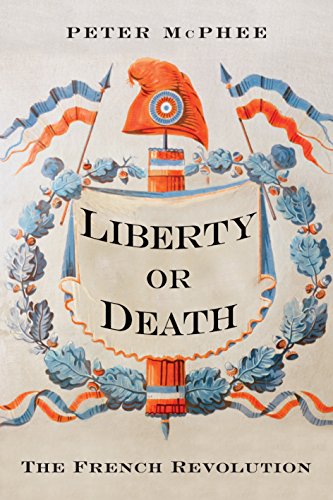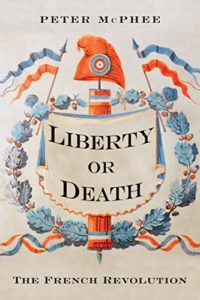

This is part of our special feature on Nationalism, Nativism, and the Revolt Against Globalization.
Peter McPhee’s latest book on the French Revolution is a narrative that begins in 1789 and ends with Bonaparte’s coup a decade later. He devotes three chapters to the crisis of the Old Regime, another three to 1789 and the reconstruction of institutions, and three more to the emergence of popular opposition that the Civil Constitution of the Clergy engendered. A stand-alone chapter on choosing sides at the micro level is one of the most interesting in the book. Three chapters on the Terror and Revolutionary government argue for the thesis of self-defense. Finally, three more chapters deal with the aftermath. McPhee’s sympathies for the Revolution are clear but unlike earlier generations of historians who implicitly denied popular opposition existed or who devoted less than a line to, for example, the drownings at Nantes, this book provides plenty of detail. He has little use for Bonaparte. He attributes his popularity to his victories alone rather than to the representation of his victories as the fulfillment of the Jacobin dream of 1792 of carrying liberty to the oppressed peoples of Europe. He never mentions that the Army of Egypt permanently liberated the Arabs from foreign and exploitative rule of the Mamelukes. In other words, McPhee provides plenty of scope for debate. Nowhere is this clearer than in his stimulating closing chapter on the significance of the Revolution.
The Revolution was important for several reasons. It established a culture of representative institutions with its attendant notions of frequent voting, popular sovereignty, extensive newspaper reading, and participation through clubs. McPhee recognizes part of the darker side of this but he could go further. The revolutionaries did not respect election results. Every legislature from the Estates General of 1789-91 to the Tribunate of 1802 was threatened, purged, or overthrown. Representative institutions had a shaky start. Other achievements were more permanent. The old system of privilege with its exemptions and seigneurialism was gone for good. Merit, not birth, however imperfectly, was the basis of advancement. Yet McPhee wants to argue that the nobility were big losers all the same. He states boldly, “The abolition of the seigneurial system was the single most significant social change brought by the Revolution. With the abolition of dues, peasants retained an extra portion of their output that was often directly consumed by a better fed population.” (357; see also 93 for a similar argument that the abolition of tithe and dues allowed peasants to support the Revolution’s higher taxes, with extra income left over). He also says that nobles paid more. In the Old Regime, they paid 5 percent of their wealth in taxes, after the Revolution 16 percent of the “annual value” of their land (354). Surely, he means annual marginal income; otherwise the state would have devoured all the land of France in a decade. No matter, it is not true. The triple vingtièmes of the 1760s and 1780s took 15 percent by definition, close to the post-revolutionary marginal rate of 20 percent, which was the aim of the Napoleonic cadastre. Moreover, nobles found the new regime’s taxes easier to pay, because landowners had the additional bonus of the abolished tithe and dues which they happily added to the lease their farmers had to pay (One noble near Laval referred to “ma dime” in his account book until 1807.) And they no longer had to pay upkeep for seigneurial courts, prisons, market halls or toll bridges. Abolition did not necessarily hurt landowners and may have benefitted the peasantry much less than is usually claimed. Above all the Revolution standardized institutions. The territorial basis of administration remains largely what it was in 1790. Equality before the law, and equal inheritance were quickly accepted. Interestingly, the Revolution started the long project of “making Frenchmen,” stigmatizing local languages and folkways as backward and counter-revolutionary. From the federation of 1790 onwards, loyalty to the nation transcended particularisms. The description of the innumerable festivals and exhortations to national unity are among the strongest in the book.
Most of the book is descriptive. This is not a bad thing because McPhee tells a familiar story very well. He aims above all to capture the provincial revolution. This is a book that shrinks the revolution in Paris. He almost seems in a hurry to get through it. The Bastille gets less than a page, the aftermath just another page. He is very strong on non-political issues like artistic salons, festivals, name changes, the changing legal status of women as their roles as participants and authors, and so on. But the political always intruded. Music that was too soothing at a concert commemorating the anniversary of the execution of Louis XVI had to be followed by a foot stomping round of the Ça Ira. The book also has a stunning collection of plates, including some fine photographs the author took himself. He is very strong on major provincial cities like Lyon, Orleans, and Marseille, while the peasantry gets a large amount of space. The risk in such a comprehensive approach is that readers become bogged down in detail. He overcomes this with a clever strategy of using diaries and letters from fairly unknown people to capture the human experience of Revolution. Consider, for example an anecdote about the villagers of Fraïsse near Narbonne. The seigneur had earlier bullied his peasant vassals but now he was shocked to observe “the sudden change [that] has taken place among them… the former vassals believe themselves to be more powerful than Kings” (cited 110). The quote obviously illustrates McPhee’s point about the importance of seigneurialism and how the Revolution empowered ordinary people. Still another example of the telling quote would be Restif de la Bretonne’s description of the murder of the Queen’s friend, the Princesse de Lamballe during the September Massacres in 1792: “…a killer seized her, tore off her dress and opened her belly. She fell, and was finished off by the others. Never had such horror offered itself to my imagination. I tried to flee; my legs failed. I fainted.” (161).
Until fairly recently, historians of the Revolution were reluctant to tell such stories but McPhee shows there were plenty of atrocities and lynchings along with the outrages of the revolutionary tribunals. He recounts these events with some courage and in detail, but he blurs responsibility. To take one example among many: his description of the repression following Lyon’s rebellion against the Convention in May-October 1793 is incomplete. He describes the decision to change Lyon’s name and the order to destroy the property of the rich but gives the impression this came as an assurance (215). He does not say it was a decree of the Convention that ordered the repression (Decree of 12 October) and that this decree established a military commission to try the rebels. A military commission could render only one verdict, death. Thus the Convention got a less savage terror than it wished for since the other two revolutionary tribunals that operated in Lyon released about half the accused who came before them. He also fails to mention that part of this decree ordered the construction of a column where Lyon once stood that would bear the famous inscription, “Lyon n’est plus.” Surely with a sentiment like this, they would never have disowned their colleague Collot d’Herbois’ project of executing all the federalist prisoners in a single giant bloodbath, a project Collot considered a lesson in civics for the corrupted Lyonnais. The Committee of Public Safety as a whole highlighted the necessity of a pitiless repression. They wrote to the representatives conducting the siege, “Are the rebels finally defeated, are they all exterminated…No weakness, no mercy …Spare only the patriots and the indigent persecuted by the rich (Arch Parl., lxxvi, 462).” Responsibility for a merciless terror originated in the Convention and with the Committee of Public Safety. The out-sized representatives on mission shared some responsibility too, of course, but the old picture of an innocent Committee discovering atrocities late and acting to recall their perpetrators will not work, if we see responsibility for repression as shared.
For McPhee, both the September Massacres and the Terror were responses to the threat of counter-revolution, the result of fear, uncertainty and self-defense (163, 253), “exceptional laws in extraordinary circumstances as they [the republicans] grappled both to create a republican society and defend it against its enemies (210).” McPhee treats this as the only possible explanation but there was more to revolutionary government than defense against internal and foreign enemies. The revolutionary tribunals were not defensive at all since every single victim of the tribunals was in custody already and many of those lynched in July through October 1789 and in August-September 1792 were as well. The tribunals were ruthless tools of punishment and in the telling of some representatives on mission, they were also instruments for pruning diseased members from the body politic. The lynchings served a similar purpose: punishment, preemption, and purification. They also reflected a lack of faith in ordinary judicial procedures because once accused, only death could result and the courts could not be trusted to render such verdicts every time. Finally, such thinking traversed the political spectrum. The murder of 400-odd (not 30000) Jacobins after the Terror in several prisons in the South, or while being escorted to prison while roped together, or in individual nocturnal killings that included women among the gangs, derived from the same script.
So, where are we with the significance of the Revolution? If like McPhee, we choose to emphasize in the final analysis, its aspirations, which for him include the social and economic justice provisions of the Constitution of 1793, we have an inspiration that continues down to the collapse of the Iron Curtain and the optimism of the Arab Spring. If on the other hand, we wish to emphasize the costs—the deaths in war and civil war and repression, the collapsed currency and consequent destruction of savings (which would have greatly harmed widows living off annuities), the withered economy, the fact there was no relief for farmers and working people except a rearrangement of the way “surplus value” was extracted, the restoration of ubiquitous indirect consumption taxes and fees on urban working people—then we have a much more sober Revolution. It is a credit to Peter McPhee’s fair-mindedness that there is material for both interpretations in this fine and thought provoking book.
Reviewed by DMG Sutherland, University of Maryland
Liberty or Death: The French Revolution
by Peter McPhee
Publisher: Yale University Press
Hardcover / 488 pages / 2016
ISBN: 9780300189933
To read more book reviews, please click here.
Published on February 1, 2018.




